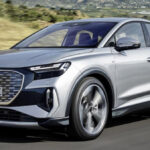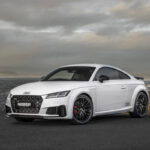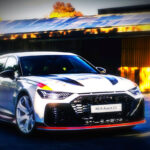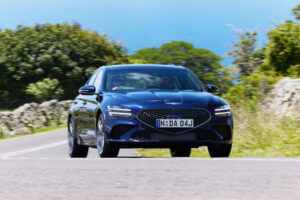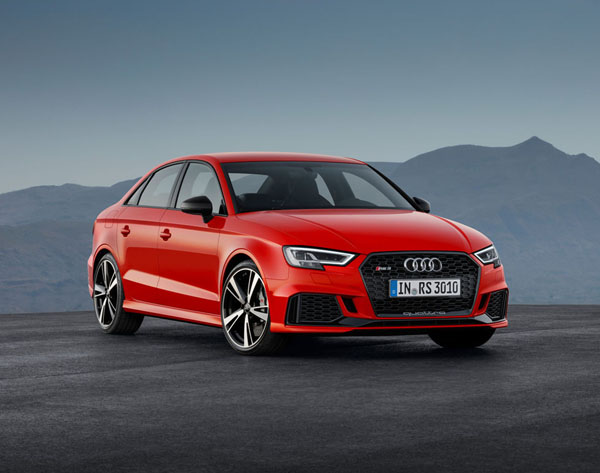
The Audi RS 3 went AWOL more than 18 months ago due to delays that Audi said were brought about by the implementation of new WLTP homologation rules in Europe.
Now the Audi icon, truly a thing of worship to some enthusiasts, is back with its 2.5-litre turbocharged five-cylinder engine fired up and ready to go. With a heritage that dates back to the legendary Sport quattro S1 Group B rally car of the early 1980s, the RS 3 makes a return as a Sedan and Sportback, the latter, Audi’s take on a performance hatchback.
The RS 3 develops 294 kW and 480 Nm from its 2480 cc capacity engine to offer outstanding performance, sprinting from zero to 100 km/h in 4.1 seconds, while returning a combined fuel consumption of 8.5 litres per 100 kilometres.
Prices start at $83,800 for the Audi RS 3 Sportback, RS 3 Sedan tips the scales at $86,500, both without on-road costs. Capping off the dynamic duo, the RS 3 offers exclusive Carbon editions for $3400, featuring a range of styling elements in gloss black to enhance their sporting characteristics.
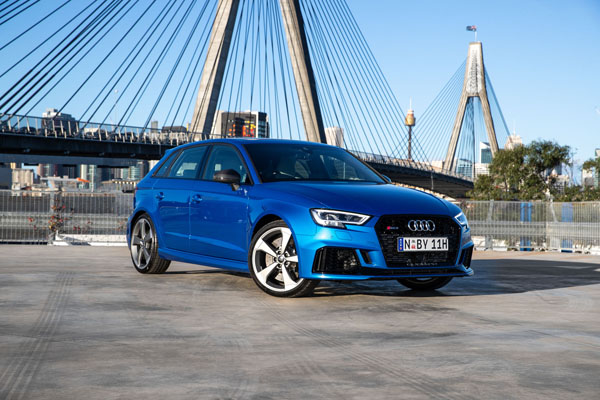
STYLING
Based on A3 architecture, the exterior design of the RS 3 Sedan that Audi tells us is aimed to give an aggressive stance. Up front, bold ‘quattro’ branding takes pride of place beneath a modern single-frame grille, while large intakes feed more air to satisfy cooling demands of the powerful engine.
Thin beams of light projected by LED headlamps and taillights are also there to emphasise the car’s attitude.
Metallic paint comes standard. Also adding further to the RS 3 character are 19-inch Audi Sport alloy wheels in five-arm blade design in matt titanium look, gloss turned finish with 235/35 tyres.
INTERIOR
The RS 3 Sedan cabin puts the enthusiastic driver in the box seat from the start with RS sport front seats, upholstered in Nappa leather, with diamond-patterned stitching, while the flat-bottom sports steering wheel features an Alcantara and leather combination that’s comfortable to grip.
An acoustic windscreen is standard, while further measures to reduce interior noise, even at high speed, include wheel housing shells made of non-woven material.
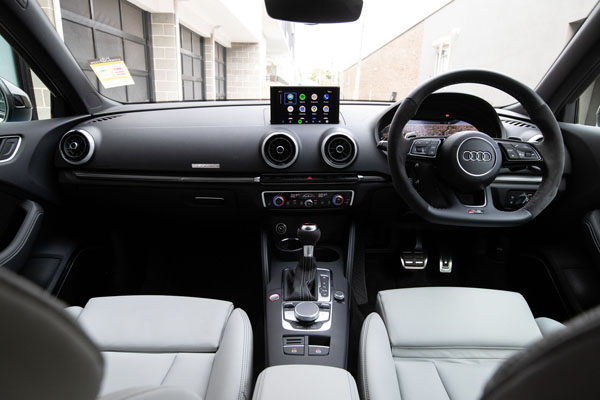
INFOTAINMENT
Audi took the traditional dial-based instrument panel and replaced it with the virtual cockpit, which allows the driver to control what information, navigation data and infotainment functions are displayed in high-definition.
A selectable sport mode features a central rev counter and performance-oriented secondary displays such as lap timer, power/torque output or charge pressure. This is supplemented by RS-specific functions such as G-Meter, shift light and tyre pressure.
Infotainment is provided through an electronically retractable colour display, including MMI navigation plus and the Audi smartphone interface for easy connection. There’s wireless phone charging, two USB ports and DAB digital radio and a Bang and Olufsen sound system with 14 speakers.
ENGINES / TRANSMISSIONS
The transverse five-cylinder engine develops a 294 kW and 480 Nm from its 2480 cc capacity. It has a lot of advanced technology, with an aluminium crankcase, dual injection, the valve-lift system and a high-pressure 1.35 bar turbocharger.
Coupled to an advanced seven-speed S tronic transmission with its virtually instantaneous gear changes and quattro all-wheel drive system are capable of redirecting huge power and torque in milliseconds to the wheels with the most traction for more dynamic, safer and involved handling.
SAFETY
The RS 3 Sedan brings a host of advanced driver assistance safety systems as standard, including side assist, active lane assist, adaptive cruise control (with Stop & Go) and rear cross traffic assist. The range has been awarded a five-star safety rating by the Australasian New Car Assessment Program.
DRIVING
With an output of 294 kW and peak torque of 480 Nm on tap as low as 1700 rpm and constant all the way to 5850 revs, the new turbocharged engine is capable of spearing the RS 3 Sedan to 100 km/h in 4.1 seconds and to the top of the class.
Audi claims a combined urban / highway fuel consumption of 8.5 litres per 100 kilometres. On test the RS 3 Sedan recorded 9.6 litres per 100 kilometres on a mix of city work and highway hauling.
The sound of the powerplant, with its 1-2-4-5-3 firing order, is amplified through the standard RS exhaust system, with active baffles in the rear muffler that can be activated via Audi drive select.
The Audi RS 3 Sportback and RS 3 Sedan utilise a seven-speed dual-clutch S tronic transmission, delivering speedy shifts. The transmission will operate automatically or with the driver manually shifting gear through steering wheel-mounted paddles.
There are two driving modes in automatic – D mode is optimised for stop / start traffic, while S mode has the vehicle in more agile mood with changes at higher revs. Here launch-control is at optimum traction getting the best out of the car’s acceleration.
The tuning of the quattro permanent all-wheel drive system is integrated into the Audi drive select dynamic handling system, where the torque delivery is distributed quickly and precisely via an electro-hydraulic multi-plate clutch, automatically sending more drive to the rear wheels during dynamic driving, to ensure ideal cornering balance.
The RS 3 Sedan features RS sport suspension and Audi magnetic ride as standard. RS 3 Sedan occupants can take advantage of Audi Drive Select which will dial up a range of handling characteristics from comfort, or auto to dynamic or individual, while also working on the accelerator pedal, steering and exhaust flaps.
In dynamic mode, the Audi magnetic ride resists braking and cornering forces on the car’s attitude, heightening agile and responsive handling. It’s strictly for trackwork.
As for ‘comfort’, it’s comfort, Jim, but not as we know it. On anything but a billiard table-top smooth road surface the RS 3 Sedan bumps and bangs its way over even minor blemishes.
Black eight-piston brake calipers clamp (and I mean ‘clamp’) 370 mm ventilated rotors at the front of the RS 3, with 310 mm discs at the rear, providing powerful stopping performance inside 19-inch alloy wheels that are wrapped in 235/35 tyres as standard.
The RS 3 Sedan is capable of carrying 315 litres of luggage in the boot, or 770 litres with the rear bench seat back folded.
SUMMARY
Nothing much has changed since the RS 3 Sportback and Sedan first appeared in 2017, which may be quite a comfort to its army of admirers, who will no doubt not be put off with the near $2000 price rise due to currency movements.
AT A GLANCE
MODEL LINE-UP
Audi RS 3 Sportback: $83,800
Audi RS 3 Sedan: $86,500
Audi RS 3 Sportback Carbon Edition: $87,200
Audi RS 3 Sedan Carbon Edition: $89,900
Note: These prices do not include government or dealer delivery charges. Contact your local Audi dealer for drive-away prices.
SPECIFICATIONS (Audi RS 3 2.5L TFSI Turbo 5-cylinder petrol, 7sp automatic Quattro Sedan)
ENGINE:
Capacity: 2.480 litres
Configuration: Five cylinders in line
Maximum Power: 294 kW @ 5850-7000 rpm
Maximum Torque: 480 Nm @ 1950-5850 rpm
Fuel Type: Petrol 98 RON
Combined Fuel Cycle (ADR 81/02): 8.5 L/100km
CO2 emissions: 194g / km
DRIVELINE: Seven-speed automatic, Quattro AWD
DIMENSIONS, WEIGHT AND CAPACITIES:
Length: 4479 mm
Wheelbase: 2631 mm
Width: 1960 mm
Height: 1399 mm
Turning Circle: 11.0 metres
Kerb Mass: 1510 kg
Fuel Tank Capacity: 55 litres
BRAKES:
Front: Ventilated disc
Rear: Ventilated disc
STANDARD WARRANTY:
Three years / unlimited kilometres




